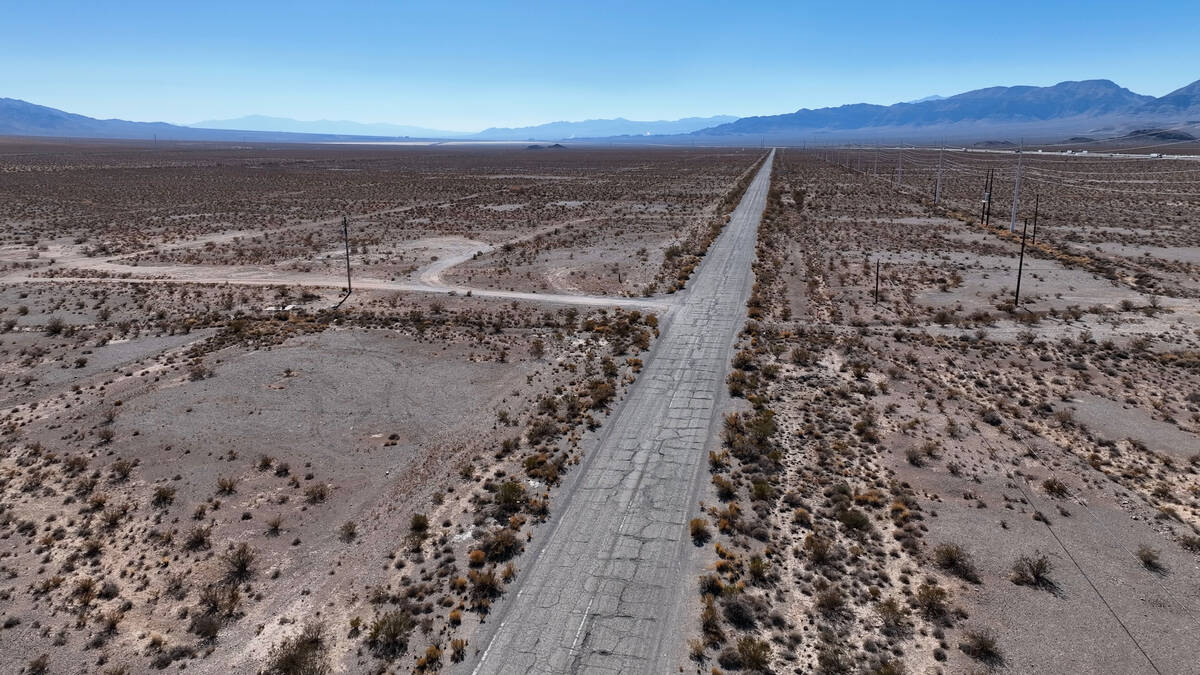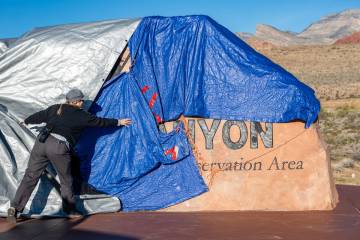Clark County’s new airport could pull from Lake Mead. Will it inspire urban sprawl, too?
Las Vegas may be in a tourism downswing, with optimism — and water — in short supply, but plans to build a second airport outside city boundaries are chugging along.
Before it can move forward, the full environmental effects of the Clark County supplemental airport will be explored in an environmental review process that takes place at the federal level as required by the National Environmental Policy Act.
Officials expect the airport’s review to take about 2½ more years, and conversations about minimizing harm to water supplies and wildlife have taken place for a decade. However, with plans to build Lake Mead water service lines out toward the airport and ongoing efforts to sell off public land in the region, some environmentalists like Vinny Spotleson wonder if the project could coincide with the wandering eye of developers in Southern Nevada.
“We’re not talking about just water for one commercial airport. We’re talking about a scheme going back 25 years to do huge real estate developments all the way down there,” said Spotleson, volunteer chair at the Sierra Club’s Nevada chapter and a Valley High School history teacher.
U.S. Sen. Catherine Cortez Masto and Rep. Susie Lee, both D-Nev., reintroduced the long-considered Clark County lands bills in March that could free up land for development in the region. The feds own most of the open spaces in Nevada, and the areas out by the planned airport are no different — a conundrum with the competing challenges of natural resource stewardship and the Las Vegas housing affordability crisis.
Spotleson, who worked on public lands issues under U.S. Sen. Harry Reid and Rep. Dina Titus, both D-Nev., said the area out by Primm has long been floated as a zone for potential growth.
No specifics on water — yet
The completion date for the environmental review is March 2028, and the airport could be more than a decade off from the end of construction.
Monika Bertaki, a spokeswoman for the Clark County Aviation Department, said in an emailed statement that the department has engaged early and often on environmental concerns, with inter-agency conversations dating back to 2016.
But the timeline means the Southern Nevada Water Authority has no indication yet as to how much demand will exist for the airport, said Doa Ross, deputy general manager of engineering. But if the infrastructure is capable of supporting new development — commercial or private housing — there would be nothing preventing builders from applying to tap into those service lines.
“Just like with every other development, when we receive information, we begin looking at, hydraulically, what’s needed to serve the development,” Ross said. “And we just haven’t gotten to that point yet.”
More specific estimates of water demands would come after the environmental review process, Ross said.
Airport officials understand the need for the airport to tap into widespread wastewater treatment in the Las Vegas Valley, she said. The technology has progressed so far that every drop of water used indoors is recycled and sent back to Lake Mead, and the airport would be no different if and when the underground service lines are constructed.
The same goes for following Clark County’s ban on new developments with evaporative cooling systems and a law that takes effect in 2027 outlawing the watering of decorative grass. Irrigating landscaping and evaporative cooling lead the list of “consumptive” water use, or water that is used and lost without being recycled.
“There is certainly the potential, if the capacity is there, that you could have other developers say, ‘Hey, I’m interested in connecting here,’” said Bronson Mack, a water authority spokesman. “And that doesn’t necessarily mean that that’s a sprawling subdivision or a big development. It could simply be some kind of a manufacturing or distribution facility.”
Early discussions about water demands have, in the past, deterred some industries from pursuing development in Southern Nevada when the water authority asked developers to reevaulate water needs, Mack added.
Interest in commercial development is there
In both the housing and commercial developer community, the airport could be promising for growth.
One organization that attended public meetings before the environmental review process began was NAIOP Southern Nevada, the commercial real estate development association for the region. NAIOP was previously known as the National Association for Industrial and Office Parks.
The ability for a truck driver to drive from the coast of Southern California and back in one day makes the Ivanpah Valley an attractive option for big industrial warehouses, said Mike Shohet, a past president still active in NAIOP Southern Nevada’s government affairs arm.
Apex Industrial Park, a massive commercial hub outside the Las Vegas Valley to the north, is just far enough that a one-day trip isn’t feasible from the coast, he said.
“Extending water service maybe provides an ancillary benefit, making that area more ready for development,” Shohet said.
Shohet believes sustainable growth is more than possible, and he’s seen his industry adapt. Twenty years ago, he said, developers would have fought the valley’s water policies “kicking and screaming,” but they have today embraced them as a starting point for innovation.
“I think there’s some merit to the statement that, we need to build denser instead of additional sprawl,” Shohet said. “But I think there’s a limit to that, as well. In my mind, the right answer is a balance between the two.”
Valley housing challenges persist
And when it comes to housing stock, early interest exists, too.
Tina Frias, CEO of the Southern Nevada Home Builders Association, said it’s far too early to know whether market conditions will allow for developer interest in the area around the airport.
If demand exists, Frias said the homebuilding industry is ready to make use of developable land.
Before housing construction is considered near the airport, however, developers would need to consider how they can minimize conflict with airport operations and ensure that proper amenities exist for people who would be living there, Frias said.
“It is not a question of whether Southern Nevada grows, but how it grows,” Frias said in a prepared statement. “Thanks to thoughtful planning, community collaboration, strong conservation policies, and continued innovation, Southern Nevada is growing, while mitigating the impact to our water footprint.”
Whatever the drawbacks may be of sprawl, growth is worth the growing pains, said Shohet, of the commercial development organization. As discourse continues about the airport, Shohet said he hopes reason prevails.
“There are a lot of people out there who would like to keep Vegas exactly the way it is,” Shohet said. “And I just don’t think that’s reasonable. You have to account for some growth.”
This story has been updated to reflect that NAIOP no longer uses the words behind its acronym.
Contact Alan Halaly at ahalaly@reviewjournal.com. Follow @AlanHalaly on X.






















